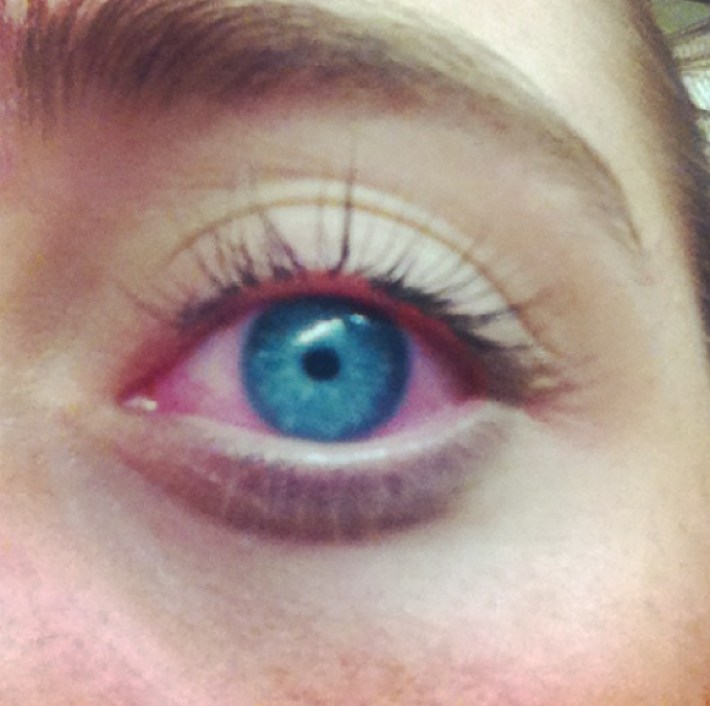10 serious diseases that can be diagnosed by the eyes
When you meet a stranger, the first thing you notice about him is his eyes: their shape, color and sometimes even the physical condition of their owner... Curious how? The fact is that eyes not only allow their owner to see. Doctors can diagnose a certain number of diseases and poor health based on the eyes. The state in which they are can help you understand the processes occurring in your body.
Through these windows into the world of your internal state, you can diagnose 10 dangerous diseases:
1. Cancer
There are several eye conditions that indicate cancer in some part of the body or even cancer in the eye itself. Lung cancer in men and breast cancer in women are often visible in the eyes even before the diagnosis is made. Quite often, basal cell carcinoma (skin cancer) is found under the eyelids or in brown spots that appear on the eye.
2. Autoallergic disease

Photo caption: typical redness
An autoallergic disease such as tuberculosis of the skin, Crohn's disease, or even some forms of arthritis can be detected through an eye examination. If you constantly have irritated or swollen eyes (and you don't drink or sleep enough), red eyes may be a sign of inflammation in your body, which is a common symptom of skin tuberculosis.
Other symptoms, such as drooping eyelids or dry eyes, may be due to Sjögren's syndrome, an autoimmune disease that destroys the body's skin glands. Additionally, drooping eyelids mean gradual muscle weakness that occurs due to various autoimmune disorders.
3. High blood pressure
Symptoms of high blood pressure and other cardiovascular diseases can be detected in the patient's eyes. According to the online publication Web MD, if the blood vessels in the whites of the eyes begin to twist, narrow, or, on the contrary, expand, then high pressure is the most likely cause of this. High blood pressure is extremely dangerous to health as it can lead to a major stroke.
4. Brain injury
Horner's syndrome is a complication of a head injury, stroke, or aneurysm that causes the pupils to be different sizes. Different pupil sizes may indicate a blastoma or tumor in the neck. The Internet publication Web MD provides a list of reasons due to which this symptom may occur. Regardless of this, if your pupils are different in size, this pathology is a sign that you immediately need to see a doctor, since a serious malfunction is occurring in the body.
5. Liver problems
Bile spillage causes yellowing of the skin and whites of the eyes. Bile spillage is caused by excess bilirubin (a waste product from the liver) that travels through the blood. Hepatitis (inflammation of the liver) or other liver problems can be caused by a spill of bile when the liver tries to remove adequate amounts of bilirubin from the body.
6. Thyroid problems
Graves' disease is a disorder of the normal functioning of the thyroid gland, which can lead to protrusion of the eyes and an increase in their size. This happens when the thyroid gland begins to affect the tissue of the eyeball. Protruding eyes are the most typical syndrome of thyroid problems.
7. Diabetes
Diabetes not only affects your blood sugar, but it can also severely damage the blood capillaries in your eyes. High blood sugar (a major symptom of diabetes) can cause these vessels in the inner lining of the eyeball to lose their elasticity, which in turn will lead to an excess supply of proteins to the macula (the part of the eyeball that is responsible for focusing vision). If blood sugar levels are not monitored and maintained at the desired level for several years, severe vision impairment and even blindness can occur.
8. High cholesterol
Another cardiovascular disease that can be diagnosed through an eye examination is high cholesterol. High cholesterol levels can cause a gray ring to form around the cornea of the eye. It can also lead to the formation of small fatty deposits in the form of blisters on the eyelids.
9. Multiple sclerosis
Multiple sclerosis often leads to inflammation of the optic nerve, which in turn leads to severely unfocused vision or sometimes no symptoms. More than 75% of patients suffering from multiple sclerosis have this symptom and quite often it is the first symptom of the onset of this disease.
10. Anemia
If the inside of your lower eyelids is white or pale it may indicate a lack of iron in your blood. Iron deficiency anemia is a typical blood disorder that can be treated with supplements, but it can also be a sign of internal bleeding.
The condition of your eyes should never reassure you. Individual symptoms of diseases are not at all easy to distinguish, and early diagnosis of your health condition by a medical specialist will help save you a lot of time and effort if symptoms are detected in a timely manner.






